While city hall will not offer students a discounted transit pass since previous fare-discount programs aimed at increasing ridership proved ineffective, new digital passes might make a difference.
City council directed city administration in February to provide information about possibly offering local organizations — such as school divisions — bulk passes at reduced costs so those groups could distribute them to students at lower rates.
After months of research, the public works department presented a report about student pass sales during the June 13 regular council meeting. The report noted that student passes are currently priced at a discount of 28 per cent compared to cash. Furthermore, reducing student pass costs would not likely lead to increased transit usage.
Offering organizations a 10-per-cent discount on passes would cost city hall about $13,000 annually.
Student monthly bus passes are sold under three categories: a standard pass is $65, a family pass with two or more members is $55, and a discounted pass is $50. However, there is extra subsidization of $25 on the third pass through the Ministry of Social Services.
“The discounted bus pass is a program that the city operates in conjunction with the Ministry of Social Services. The ministry provides a $25 subsidy to the city for each pass sold, with the city subsidizing the remaining $15,” said Darrin Stephanson, director of public works. “Discounted passes account for 10 per cent to 15 per cent of total student passes sold.”
To be eligible for the discounted pass, individuals must be enrolled in one of four social services programs: Saskatchewan Assured Income for Disability (SAID), Provincial Training Allowance (PTA), Saskatchewan Employment Supplement (SES), or Saskatchewan Income Support (SIS).
Stephanson provided a graph showing the number of student passes purchased during the last 10 years. In January 2013 there were around 250 passes sold, while in January 2022 that number stood at roughly 180 passes.
The graph also showed that student sales declined from 2017 to 2020, which mirrored the decline in regular transit ridership. This decline occurred even though city hall reduced regular transit cash fares to $1.25 from $2.25.
“We were somewhat surprised to see a decline in student passes even though they were left at the same cost. It was cheaper to pay with cash than with passes,” he said.
At 20 trips per month twice a day, it would cost a student $50 per month in cash to ride, which is only $2.50 less than purchasing a pass.
However, the good news is that city hall has seen a steady increase in student sales since last September, while sales have reached 83 percent of pre-pandemic levels, which mirrors regular transit ridership, Stephanson continued.
City hall plans to offer digital passes via smartphone apps in September, with municipal officials speculating that this could increase sales due to the greater ease of purchasing passes for digital-focused youths.
The city recently offered a soft launch of the digital transit pass program to work out any issues, said Stephanson. Bus drivers have been informed about managing these passes when on users’ smartphones.
“That is an exciting development, that we have gone into the 21st century and offer this in other ways other than paper passes,” he continued. “So it’s a lot more convenient. We do think this will drive additional membership … as convenience is key to these users.”
These digital passes will likely be a “game-changer,” said Coun. Heather Eby. However, for the program to be successful, city hall must communicate effectively with the students about the passes’ availability, while the youth advisory committee should also be informed.
The next regular council meeting is Monday, June 27.




